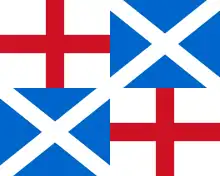
There were a variety of flags flown by ships of the Commonwealth during the Interregnum of 1649–1660.
At sea, royalist ships continued to fly the Union Jack of 1606, while on 22 February 1649 the Council of State decided to send the parliamentary navy an order (signed by Oliver Cromwell on 23 February) that "the ships at sea in service of the State shall onely beare the red Crosse in a white flag" (viz., the flag of England). On 5 March 1649 the Council further ordered "that the Flagg that is to be borne by the Admiral, Vice-Admiral, and Rere-Admiral be that now presented, viz., the Armes of England and Ireland in two severall Escotcheons in a Red Flagg, within a compartment."[2] A sole surviving example of a naval flag following this description is kept by the National Maritime Museum at Greenwich, others having fallen victim to the destruction of Commonwealth symbols at the Restoration of Charles II.[3] Scotland was formally united with England in 1654. According to Perrin (1922), the saltire of Scotland did not reappear on naval flags of the Commonwealth until 1658.[4]
In 1658 Cromwell's personal standard as Lord Protector became the 'Standard for the General of his Highnesse fleet', while the Cross-and-Harp jack was replaced by the "Protectorate Jack", consisting of the royal Union Flag with the addition of the Irish Harp at the centre.[5]
Flags of the Commonwealth
 A flag used by the Commonwealth Parliamentary Navy and privateers beginning on 22 February 1649.[6]
A flag used by the Commonwealth Parliamentary Navy and privateers beginning on 22 February 1649.[6]![A flag of the Commonwealth flown by the Admiral, Vice-Admiral, and Rear-Admiral. On 5 March 1649 the Council ordered "that the Flagg that is to be borne by the Admiral, Vice-Admiral, and Rere-Admiral be that now presented, viz., the Armes of England [Red St. George Cross on white] and Ireland [gold harp on blue] in two severall Escotcheons in a Red Flagg, within a compartment."](../I/Flag_of_the_Commonwealth_(1649-1651).svg.png.webp) A flag of the Commonwealth flown by the Admiral, Vice-Admiral, and Rear-Admiral. On 5 March 1649 the Council ordered "that the Flagg that is to be borne by the Admiral, Vice-Admiral, and Rere-Admiral be that now presented, viz., the Armes of England [Red St. George Cross on white] and Ireland [gold harp on blue] in two severall Escotcheons in a Red Flagg, within a compartment."
A flag of the Commonwealth flown by the Admiral, Vice-Admiral, and Rear-Admiral. On 5 March 1649 the Council ordered "that the Flagg that is to be borne by the Admiral, Vice-Admiral, and Rere-Admiral be that now presented, viz., the Armes of England [Red St. George Cross on white] and Ireland [gold harp on blue] in two severall Escotcheons in a Red Flagg, within a compartment." Flag of the Commonwealth from 1651 to 1658.
Flag of the Commonwealth from 1651 to 1658..svg.png.webp) Standard of the Lord Protector from 1653 to 1659.[7]
Standard of the Lord Protector from 1653 to 1659.[7].svg.png.webp) A flag used by the Commonwealth after 1658.[7]
A flag used by the Commonwealth after 1658.[7]
See also
Notes
- ↑ "Commonwealth Standard | Royal Museums Greenwich".
- ↑ cited after Dave Martucci, 29 September 1999
- ↑ image provided by Nick Flowers, 3 May 2010
- ↑ Perrin, British Flags (1922), p. 64
- ↑ Wilson, Flags at Sea (1986), p. 19: "In 1658 Cromwell's standard as Lord Protector, in which the cross of St. George was quartered with the cross of St. Andrew and the Irish Harp, and surmounted by an escutcheon with Cromwell's personal coat of arms, became the 'Standard for the General of his Highnesse fleet' and the Cross and Harp jack was replaced by the old Union Jack with the addition of a harp in the centre."
- ↑ The parliamentary navy was ordered by the Council of State on 22 February 1649 as follows: "that the ships at sea in service of the State shall onely beare the red Crosse in a white flag"
- 1 2 Timothy Wilson, Flags at Sea (1986)
References
- Dave Martucci, Christopher Southworth, Vincent Morley, Jarig Bakker, United Kingdom: Flags of the Interregnum, 1649–1660. Flags of the World (1999, 2010). Retrieved 30 March 2011.